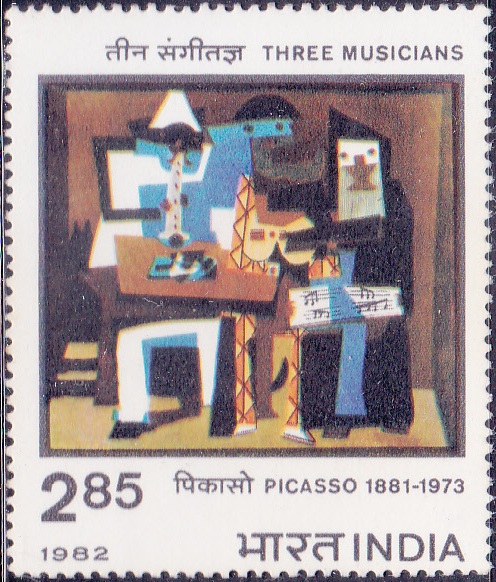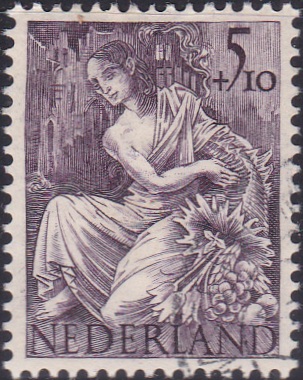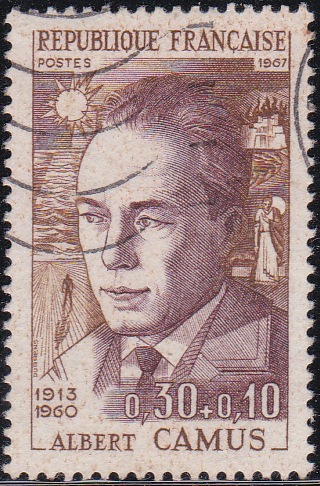
India on Picasso
A commemorative postage stamp on the Birth Centenary of Pablo Picasso, a Spanish painter and sculptor :
Issued on Mar 15, 1982
Issued for : Indian Posts & Telegraphs Department feels honoured to issue a commemorative stamp in honour of Pablo Picasso.
Description of Designs : The stamp depicts Picasso’s ‘Three Musicians‘ available at the Museum of Modern Art, New York. First day cover has been designed by K.K. Hebbar, and Cancellation by Charanjit Lal.
Type : Stamp, Mint Condition
Colour : Yellow, Red, Blue and Black
Denomination : 285 Paisa
Overall size : 4.83 x 4.06 cms.
Printing size : 4.4 x 3.6 cms.
Perforation : 14 x 14
Paper : Unwatermarked adhesive stamp paper
Number printed : 20,00,000
Number per issue sheet : 50
Printing process : Photogravure
Designed and Printed at : India Security Press
Name : Pablo Diego José Francisco de Paula Juan Nepomuceno María de los Remedios Cipriano de la Santísima Trinidad Ruiz y Picasso
Born on Oct 25, 1881 at Málaga, Spain
Died on Apr 8, 1973 at Mougins, France
About :
- Doubtless, Picasso was one of the greatest artists of all times. Like Leonardo-da-Vinci, Michelangelo, Rembrandt and Rubens, he was a creator par excellence. He excelled as a pioneer not only in paintings, but also in sculptures, graphics, ceramics and in designing the stage decor. In one respect, Picasso was even unique in that “probably no painter in history has been so much written about – attacked and defended, explained and obscured, slandered and honoured by so many writers with so many words – at least during his life time“.
- Pablo Ruiz Picasso was born on October 25, 1881, in Malaga, Spain. After his initial training in Spain, he went to Paris. He showed his professional talents in the works usually painted during late 1901 to early 1904. This is commonly called the ‘Blue Period‘. During this period, more or less, he abandoned painting of the landscapes, street scenes, dance halls and flower pieces, etc. in order to concentrate only on the human figures. From 1905 onwards, a more natural style developed emphasising a kind of sweetness in the series of Circus people. His paintings began to reveal the ‘Classic‘ characteristics, more objective in feelings and full of freshness, repose and tranquility. In order to paint his new classic forms, Picasso usually used colours such as pinks and tans, at times, contrasting them with ochres and olives or pale blue which were often dominated by a reddish monochromatic effect. This effect was so obvious that this period i.e., between later part of 1905-1906, is usually called as the “Rose Period“.
- Along with George Braque, Picasso evolved “Cubism” and became its dominating force. Cubist artists broke up natural forms such as figures, draperies, landscapes and still life etc. into planes which are tilted, shifted and compressed into the limited defined space. The emphasis was on semi-abstract designs and other formal elements. From 1907 onwards, Cubism had at least three principal variations. First, “Analytical Cubism” which requires that, motivated by the spirit of analysis and investigation, the artist dissects natural forms, reducing them to semi-geometrical shapes. These are then again broken, dislocated or flattened into rectangular or semi-circular segments. Second, “Synthetic Cubism” which emphasizes the conceptual approach and a synthesis of the varying views of the object or their semblances on the picture plane, and also permits the use of arbitrary and varied texture, materials, colours and a free combination of quasi-geometric shapes – extremely remote in character from the original image. Third, ‘Curvilinear Cubism‘ according to which cubist or semi-cubist abstract pictures are produced through curves which along with other elements later paved the way for the ‘Convulsive’ and ‘Disquieting’ works, resembling certain elements of Surrealism.
- During the 1920s even when Picasso was involved in Cubism and was attracted toward certain manifestations of Surrealism, simultaneously he also painted in the “Neoclassical” style. Picasso also believed that, at times, an artist is also a “Political being” and a painting is not done merely to decorate the apartment but ‘is also an instrument of war for attack and defence against the enemy‘. This is amply demonstrated by his greatest master-piece “Guernica, 1937“.
- The painting “Three Musicians” done at Fontainebleau during the summer of 1921 is certainly the high point of Synthetic Cubism, at least among those which accentuate the rectilinear phase.
- (Text by courtesy Dr. L. P. Sihare).








I have three musicians Picasso Indian post ticket . I want to sell this beautiful condition post ticket..